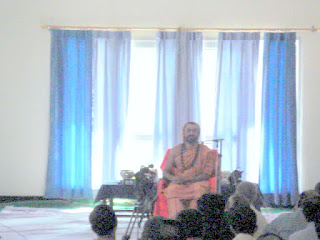The Saraswati yatra began on 30th October 2007. Around 250 Yatris arrived in Delhi by train, flight & road to join this pilgrimage from as far as Australia, USA, UAE, Hyderabad, Bangalore, Mangalore, Gokarn, Dharwad, Goa, Pune, Mumbai and Ahmedabad. All the Yatris assembled at the Nizammudin railway station where eight buses were ready and waiting. They were given a warm welcome by the Delhi volunteers.
The enthusiasm of the Yatris had no bounds. During the long 5 hour journey to Kurukshetra, including a stopover for lunch on the way, they were bubbling with eagerness and anticipation. Some sang Bhajans, some exchanged jokes, while others played Antakshari, and some even did mimicry. Each one revealed their hidden talents, just like the animated dancing peacock that shows off the vibrant colours of his feathers – one of the Vahanas of Saraswati Devi, the presiding goddess of wisdom, knowledge, arts and culture.



At Kurukshetra:
On reaching Kurukshetra, P.P. Swamiji gave an introductory address after Deepnamaskar and Samuhik Dhoolbhet. P.P. Swamiji encouraged the yatris to make the most of the opportunity to soak in the grace that was being showered on each one by the Higher Force. The room allocation was carefully planned. H.H. and retinue along with 150 senior Yatris were accommodated in the Neelkanthi Yatri Niwas and the 100 younger Yatris in the Jat Dharmashala, just 5 minutes away. A yatra folder containing a ‘Potli’ of mica-sand from the recently discovered Saraswati river bed site near Kurukshetra along with an article written by Shrikant Talgerimam and the book ‘Footprints of Saraswats’, written by Gajananmam Heranjal was distributed to all the Yatris.

 The river bed site:
The river bed site:Yatris visited an archaeological site at Bhore Saidan, 13 kms from Kurukshetra. This is one of the latest discoveries of Shri R. Purohit, the curator of Shri Krishna Museum, and his team along with ASI. As recent as November 2006, at Bhore Saidan in Kurukshetra, the actual river bed of the Saraswati had been identified, where Himalayan minerals and an abundant quantity of mica have been unearthed. The pottery and the terracotta artifacts found at this site were tested by carbon dating method by ASI, which confirmed its age to be over 3000 years. The deposition of different layers of alluvial soil, clay, mica-sand, etc, can be clearly seen with the naked eye. The same mica-sand has been packed in small pouches as memorabilia and placed in the folders handed out to all the Yatris. Geetopadesh site:On the way back, the Yatris stopped for a ‘sound and light show’ at Jyotisar. There, under an ancient banyan tree, which is an offshoot of the very tree that is believed to have witnessed the Mahabharata war and Lord Shri Krishna’s Geetopadesh to Arjuna, the Yatris recited chapter 12 and 15 of the Bhagavad Gita.Several other sites:In the evening, in the benign presence of P.P. Swamiji, Shri Purohit gave an elaborate presentation on the number of archaeological sites and the artifacts excavated in the Brahmavarta region that lies between Saraswati and Drishadvati rivers. He reiterated that the Indo-Saraswati civilization was much greater and older than the Indus valley civilization. He quoted several references to river Saraswati from the Vedas and the Mahabharata and convincingly correlated them with his findings. He gave a beautiful interpretation that the subterranean Saraswati in her Gupt form symbolizes the Shushumna Nadi while the Yamuna and the Ganga represent the Ida Nadi and the Pingla Nadi. The Yatris soaked up the information that Shri Purohit so passionately delivered. The presentation was followed by a question and answer session with Shri R Purohit and Shri D K Hari.





 Multifaceted display:
Multifaceted display:





No comments:
Post a Comment